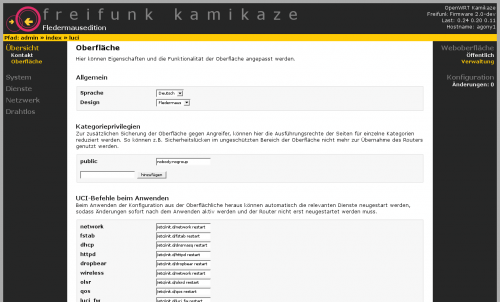Steven Cyrus Barth im Gespräch mit Bastian Bittorf über das Freifunk-Luci-Interface für OpenWRT.
Luci-Interface für OpenWRT von Steven Cyrus Barth from Mario Behling on Vimeo.
Some more info in English: FFLuCI is a Lua MVC-Framework for Freifunk with templating support. There are
working configuration pages for many system, network, services and wifi settings. Please visit http://luci.freifunk-halle.net for an overview of functions, screenshots, tutorials, SVN URL and snapshot images for Atheros and Broadcom.
Steven Cyrus started to develop Luci because he was not satisfied projects like XWRT implemented things. He had a look at the X-WRT Lua files in their repository first, but what was missing was a clear abstraction layer and templating support so I decided to build everything from scratch. According to Cyrus – X-WRT has a very nice UI written in shell code but there are only limited capabilities of this scripting language and so "it is time
to bring this thing to the next level using OOP and such nifty stuff."
Luci already has a number of working configuration pages. There are more – or in a few cases less – working configuration pages in (for now) German titles and descriptions for the:
- Ethernet Switch
- Ethernet Interfaces
- DHCP-Server
- PPPoE/PPTP
- Static Routes
- Portforwarding
- Firewall
- QoS
- Wifi Devices
- Wifi Networks
- OLSR + Plugins
- FFLuci itself
- Package Management
- Root Password and SSH-Public Keys
- Mount Points for external drives
- HTTP-Server
- SSH-Server
- Dnsmasq
Also there are a few public status pages for basic system information, WLAN-Scan, Contact data and OLSR a bit like those in the Freifunk Firmware. Have a look at the screenshots here: http://firmware.freifunk-halle
Configuration Bind Interface (CBI):
You just describe the data model of the UCI file and Luci does the rest for you: It will create the HTML-form, parse and validate the user input and write the configuration data to UCI. So no need to redo all these things on every configuration page again and again. It also supports basic field dependencies, dynamic validation functions, section creation, deletion and more. See an example here: http://wiki.freifunk-halle.net
Privilege dropping:
To avoid remote exploits (like those in older versions of the Freifunk Firmware) FFLuCI will set the UID/GID of pages running in the main public non-protected section to nobody/nogroup. There are many things left to do like porting over dhcpsplash, accounting, statistics and more to Kamikaze. Contributors are welcome.

Links:
